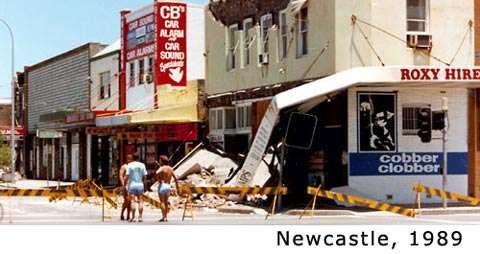Today, on Friday March 11th, 2011, 380km north east and offshore from Tokyo, we’ve just witnessed (via Al Jazeera and a steady stream of twitter feed updates), the 7th most powerful earthquake ever measured. The helicopter footage being livestreamed to browsers all over the world shows scenes of unthinkable scale and devastation, comes mere weeks after a tragic earthquake in New Zealand (6.2 on the richter scale and likely 200+ dead), and all the while, I’m getting flashbacks to a television program that aired in the 90s..
On January 17th 1995, just before that evening’s documentary was about to start, an SBS TV presenter addressed the audience, reminding us that SBS TV schedules its programs long in advance, and the coincidence of an earthquake in Japan’s Kobe earlier that morning ‘should make the following viewing all the more sobering’. The Kobe earthquake killed at least 200 people and measured 7.2 on the richter scale, and the program was Sixty Seconds That Will Change The World ( see also Amazon link for the out of print book ).
I was watching this in Newcastle, which six years earlier had suffered an earthquake of 5.6 on the richter scale, the first Australian earthquake in recorded history to claim human lives, killing 13 people. It was also the earthquake that taught me earthquakes don’t only happen where fault-lines exist. Newcastle isn’t on any fault-line, so when the family room I was in at the time started swaying from side to side (think square cross-section becoming a parallelogram), my brain interpreted this surreal transformation as the neighbours reversing their car into our house. Running outside, I found a street full of frantically gesturing people and realised the problem was of greater scope than I’d imagined.
The TV program being screened in 1995 showed Peter Hadfield, a Tokyo-based journalist and former geologist, interviewing Japan’s leading geologists, engineers and economists. To begin, the contemporary significance of Tokyo was laid out for viewers – the huge population, the sheer value of Tokyo real estate, and Tokyo’s status as a financial centre in an increasingly interlinked global economy. Geologists explained how earthquakes happen and described the inevitability of a very big earthquake sometime in the near future, given Tokyo’s position and geological history. To give some perspective – the ‘Great Kant’ earthquake of 1923 devastated Tokyo and killed more than 100,000 people. It measured 7.9 on the Richter scale. Notes wikipedia, “The power and intensity of the earthquake is easy to underestimate, but it managed to move the 93-ton Great Buddha statue at Kamakura which was over 60 km away from the epicenter. The statue slid forward almost two feet.” Today’s offshore earthquake was 8.9 (and making that worse – the richter scale is not linear but logarithmic – ‘an increase of one step corresponds to a 101.5 ≈ 32 times increase in the amount of energy released, and an increase of two steps corresponds to a 103 = 1000 times increase in energy’).
Engineers and politicians acknowledged the inevitability of the coming ‘Great Earthquake’ / ‘The Big One’.. and discussed Tokyo’s state of the art technologies and processes of preparation. Earthquake drills were demonstrated, ultra-sophisticated fire engines were put through their paces. And then a combination of experts described the likely scale and impact of the threatened quake, how this would mean the near redundancy of any preparations (‘Those fire engines will be useless, because in a lot of locations there will be no such thing as roads’), and outlined the ramifications of this for the global economy (A major financial nerve centre being wiped out? Instant global recession).
The takeaway message:
If (and when) Tokyo collapses, we all crash.
As Al Jazeera loops footage of today in the background, it’s hard not to remember just how small we all are.
Crisiwiki maintains a list of ways to stay up to date, donate, or help out.

